When you open a new brick-and-mortar business location, one of the most important projects you'll need to do is create and install exterior signage. This may seem obvious but your exterior signage is often the first impression your customers will make about your brand. Admittedly, we drive or walk past exterior business signs daily without really “seeing” them. So, your goal should be to find a way to grab attention and build brand awareness.
With the right partner, the sky's the limit on developing the perfect exterior sign. There are many styles, materials, and installations to choose from and regulations, limitations or other factors to consider. There are also common misconceptions and myths about the design or installation process. It helps to be fully informed when purchasing exterior business signage.
If you are unsure what questions to ask, this post will help. As an exterior business sign company, it's important that we provide our clients with all the information they need to make smart purchase decisions. Here are the ten questions all business leaders should ask their sign vendor when purchasing an exterior sign for a business location.
Question 1: What kind of sign should I order?
There are many signage options to choose from depending upon where the sign will be located and the look you are trying to achieve. Listed below are the most common sign types.
- Channel letters are three-dimensional graphic pieces in the shape of letters, numbers, or characters installed on the side of a building. They are often lit inside or backlit. The pieces spell out your brand name, address, or other messaging. The individual pieces are constructed with acrylic and aluminum sheeting in many colors and sizes.

- Push-through acrylics are aluminum or cabinet signs with clear or vinyl-covered acrylic letters, numbers, or characters pushed through the face. This gives the sign a three-dimensional look. In addition, the face and letters can be illuminated for better visibility. These signs are often mounted to the sides of a building.
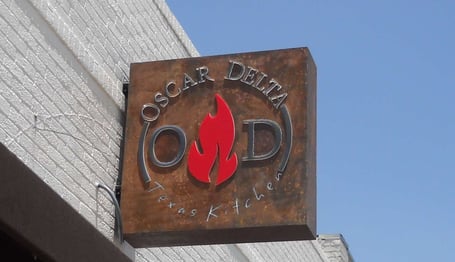
- Wall-mounted exterior signs are flat signs that can be illuminated or non-illuminated. Wall-mounted signs have an almost endless variety of sizes, shapes, and colors. You could include your logo and other graphics if you would like.
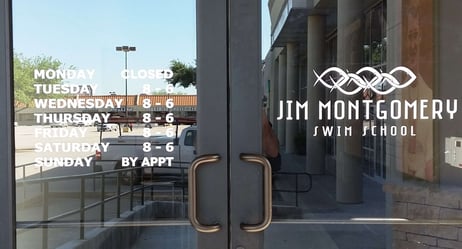
- Monuments are large, free-standing, weather-resistant signs that sit close to the ground and are at about eye-level height. They are embedded into the ground and are very durable. You can use a wide variety of materials for monuments, including stone, tile, marble, brushed and mill finish metals, vinyl, and more.
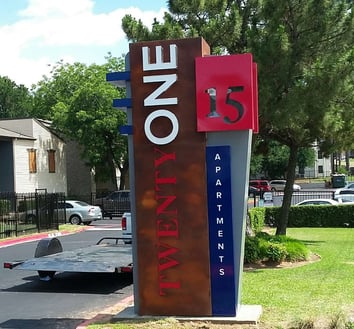
- Pylon or pole signs usually are between 8 and 20 feet tall. They can be one- or two-sided and supported by one or two aluminum or steel poles. These signs are meant to catch your eye from farther away because they are often taller than the surrounding buildings.
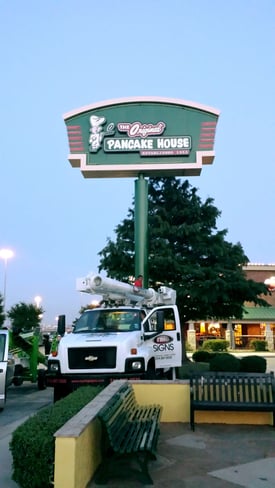
- Outdoor digital signage are most likely LED signs. These signs also include a control system, software, and networking equipment to program the messages from a distance. LED outdoor signs can be huge and are more than bright enough to see the display during the day. LEDs are also durable and energy efficient. Your LED sign can have color and graphics.
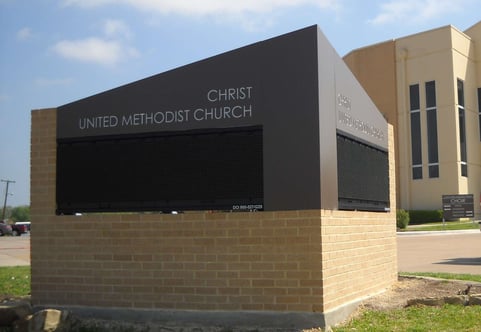
Question 2: Where should I place the sign?
This answer will depend on the type of sign you choose as well as the layout and location of your building. Of course, you want to place your sign in the most visible place, where people can see it from all directions. For that reason, corners are always a good place for signs near a road; and the higher you place your sign the better, in most cases. However, there may be regulations that will dictate where you place your sign.
Question 3: What are the rules and regulations surrounding signage on the property?
Many cities and towns have strict rules about the design, placement, and installation of exterior signage. This is especially true if your business is in a historical district where the city is trying to maintain the traditional aesthetics of the area.
For example, your city may have restrictions for how signs can be installed on historic buildings. Before any work is done on your behalf, you or your sign partner should determine the rules and regulations for external signs and what you need to do to get a permit. This is crucial step. You could waste time and money on designing a sign, choosing placement, and even installing it, only to start all over again when the city gets involved because their rules weren’t followed.
Question 4: What materials should I use?
With an expert team like Phase 3, every exterior sign is custom-made. Use your brand style guide to design a visually appealing sign that stands out from the crowd. Incorporate your brand fonts and colors, even your logo, depending on the type of sign you choose. Please note that the more unique the sign, the more expensive it may be. For example, a sign made from a material like copper can not only be costly but also an opportunity for theft. Your Phase 3 team will guide you in selecting the best materials and substrates for your particular needs.
Question 5: Should I light my sign?
If you need to light your exterior sign, ensure your sign manufacturer is UL certified. This certification means that the electrical parts of your sign will meet all governmental safety and consistency requirements for electrical work. This is an essential benefit to you because it shows your sign partner is willing to go the extra mile to ensure your sign is the best it can be and will last a long time. However, not all sign companies are UL certified, so check before you choose a partner.
Question 6: How long will my sign last?
The answer to this question will depend on the materials used to manufacture your sign. Different sign substrates have different lifespans. It might help to plan when you think you will need to update your sign. Are you considering a rebrand or a name change in the next few years? Is a merger or company buy-out in your future? Will you have to move your sign because of pending road construction? If so, you can choose modifiable materials or less expensive materials that have a shorter lifespan. The more durable materials you choose, the longer your sign will last. Of course, your sign will also last longer if you do all you can to maintain it. Choose materials that are easily cleaned and repaired as needed.
Question 7: How long will my sign project take?
As with all these questions, that answer will entirely depend on your sign needs and schedule. The most important thing you can do when working with a sign partner is to tell them upfront if you have a hard and fast target date for completion. The sooner your sign vendor can start planning the schedule, the better chance you have to avoid timing issues during the project.
There are specific timeline issues that your sign partner will have little control over, such as design approvals and permitting from your city. We suggest planning for the process to 6 to 8 weeks at a minimum for design, fabrication, permitting and installation. Factors such as complicated permitting processes, code inspections and historical or design approvals can extend the project by weeks or even months.
Once permits are obtained, your sign will be constructed and installed. The more complicated your sign, the longer this phase will take. In many cases, final approval by the authorities is required after your sign is installed. Keep in mind that the weather will be a factor in the timeline as well.
Question 8: What type of warranty comes with my sign?
The standard warranty for most exterior signs is one year. This covers faulty installation or materials but it does not cover damage done by animals or the weather.
Question 9: How much will my sign cost?
There is a wide range of costs for exterior signage, and a well-made custom signs can be expensive. However, as the saying goes, you get what you pay for. You will not find a suitable substitute vendor online. For example, while you may be able to order a neon sign on Amazon, it will not be good quality and will not last long.
When reviewing sign pricing, ensure you compare apples to apples in materials, manufacturing, and installation. Some vendors might quote a lower cost using less expensive materials or cut corners on installation. Also, consider other vendor costs that may not be included in the quote, like an attorney (for permitting) or a contractor (for installation).
Question 10: What is your process for creating an exterior sign?
At Phase 3, every sign we make is custom. Our process is based on a collaborative approach with our clients. Each client meets with our seasoned team to ideate and build a sign that meets every need. Some clients come to us with a detailed sketch, and others come to us with a very loose idea. Either way, we’ll work with you to uncover what works best for your situation and puts your brand in the best light.
The next question our team will ask after vision is about the budget. We need to understand your budget limitations to make the appropriate recommendations. When we are clear on your budget, we can find the best materials for your job. Our team will only propose materials or designs within your budget unless more expensive materials are necessary for safety or city regulations.
With the design idea and budget established, we will provide you with detailed renderings at the proper scale, placed in a photo of your location, so you can visualize exactly what the final product will look like. We will never start building your sign until all permitting and approvals are final. That way, if changes need to be made to the design or installation, no time or materials are lost.
What makes our company different from other sign companies is this consultation process. Many companies will not visit your property or ask strategic questions before starting the design process. When they skip those steps, you risk having to go back and redesign your sign when the wrong dimensions or materials were used, or your budget was not considered. We hope these questions will avoid those mistakes and make the process less expensive and more successful for you.
We are proud to announce that TMG Signs is now a part of the Phase 3 family. Located in Dallas, Texas, TMG Signs expands Phase 3’s ability to offer outstanding exterior signage. For more information about Phase 3’s commercial sign capabilities, contact us today.